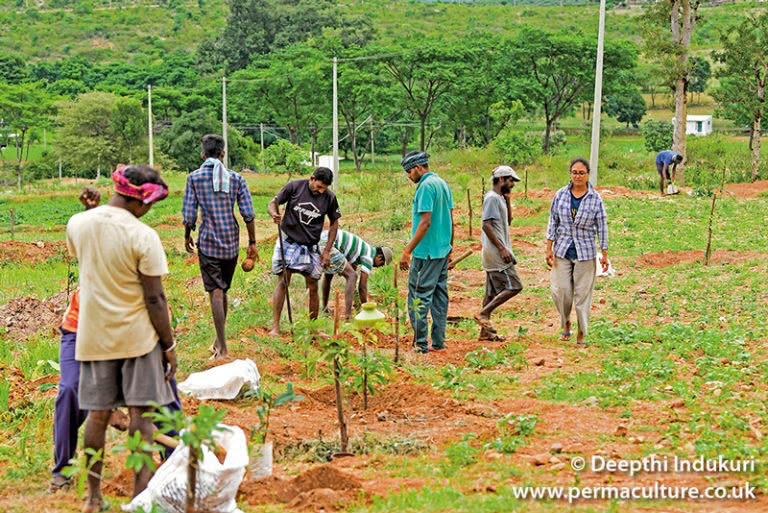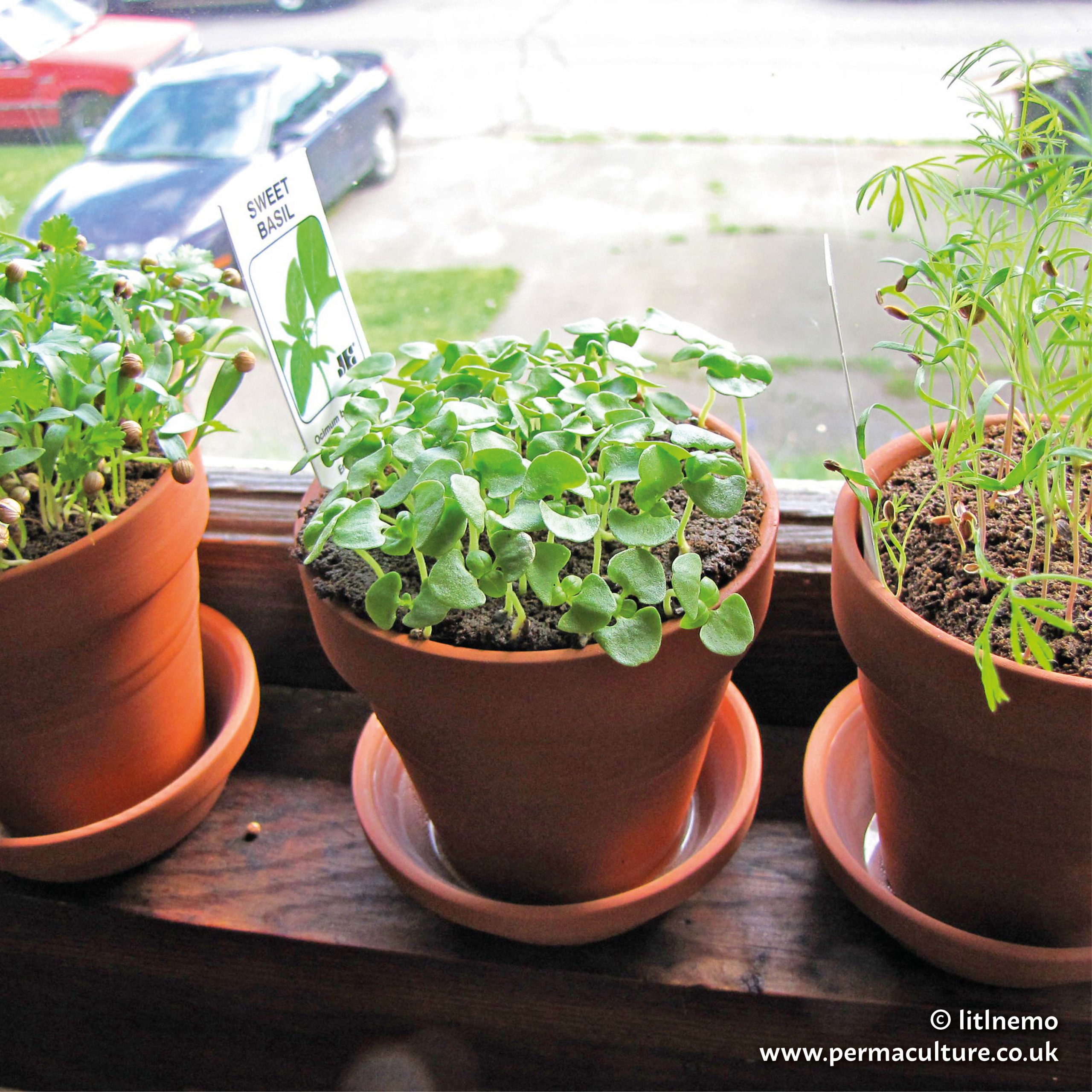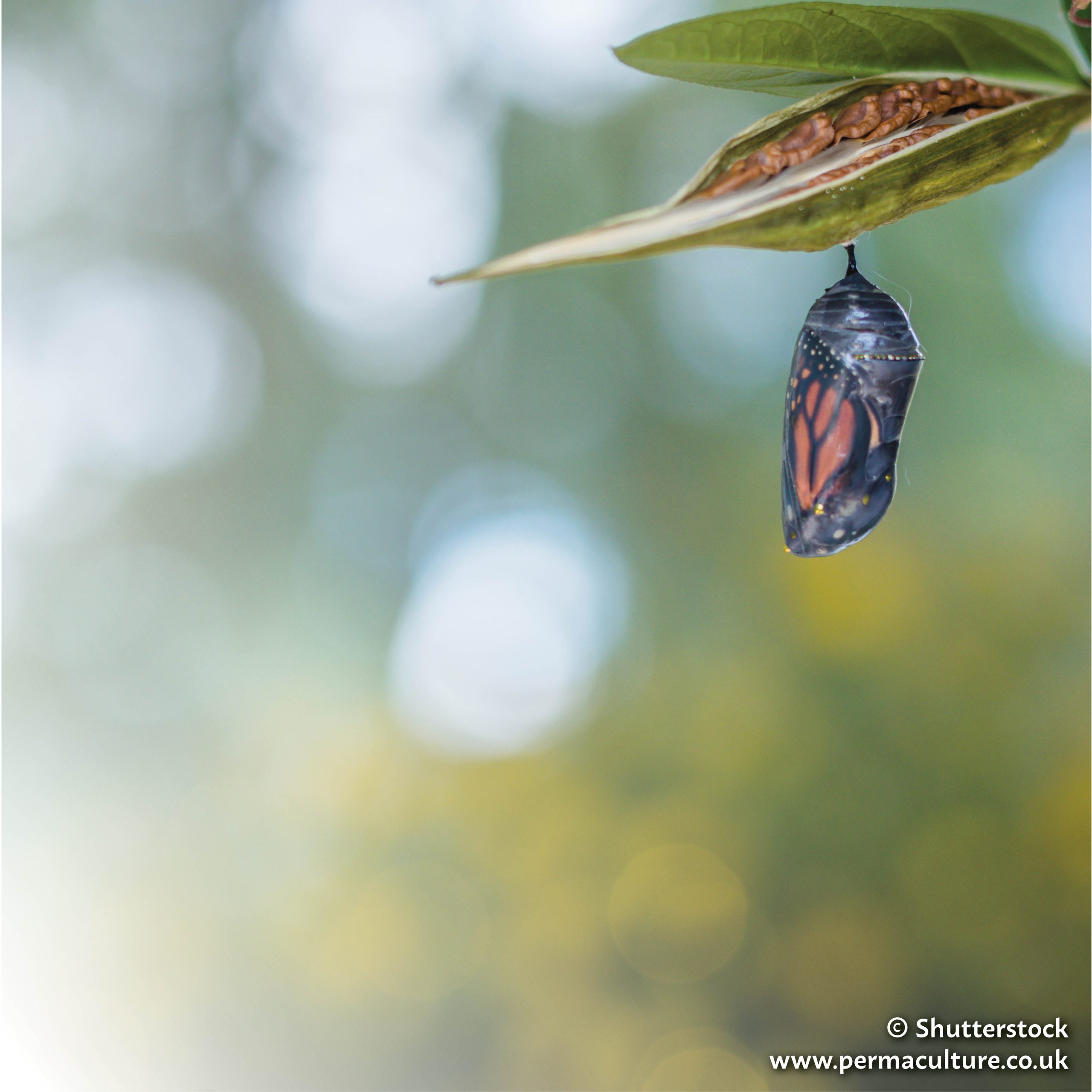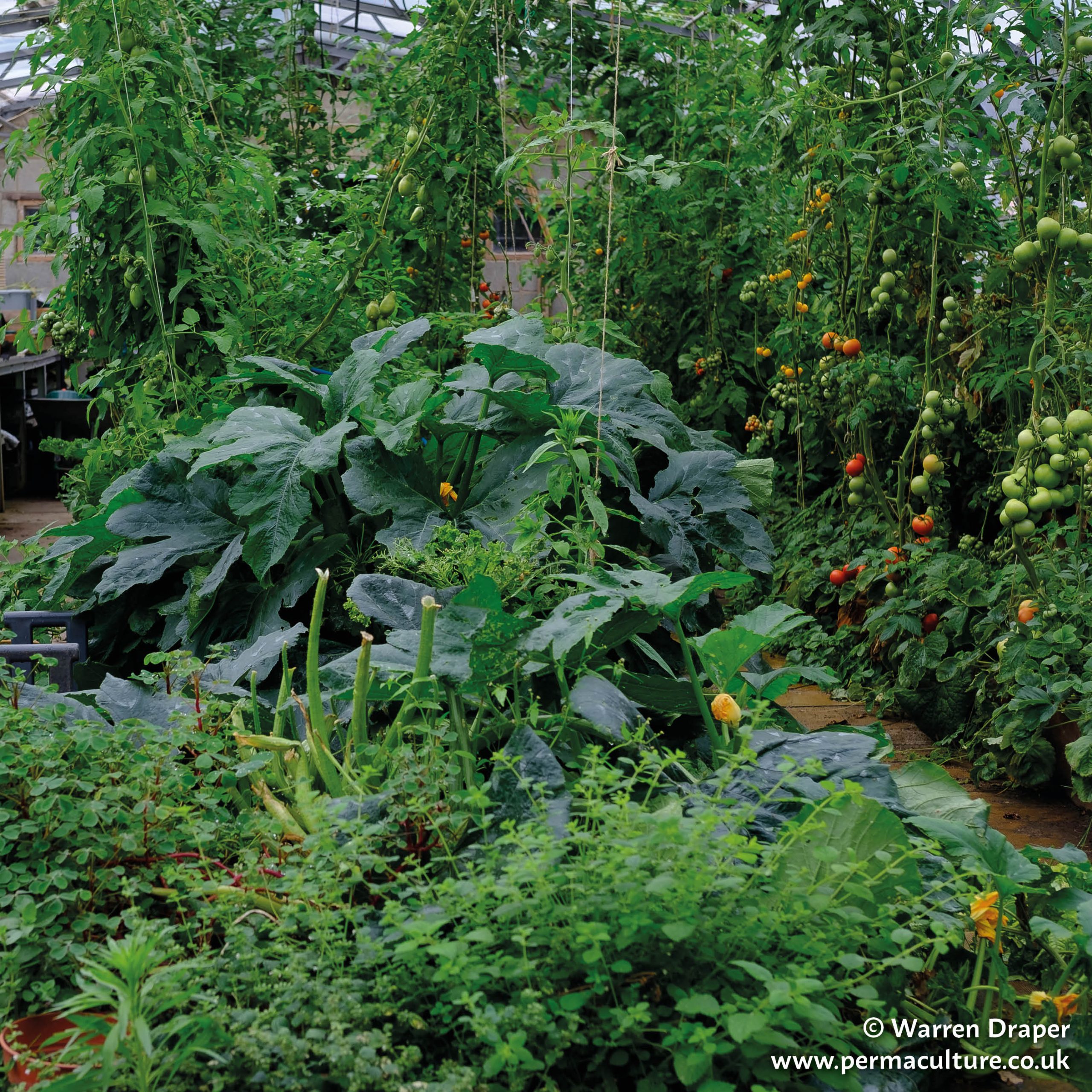I am often asked if I am self-sufficient with my forest garden. My answer is that I am not aiming to be. I am aiming to reduce my impact on nature in how I get my food, and self-sufficiency as an aim in itself does not necessarily help here. Foods that we buy vary hugely in their environmental impact. Some plants are simple to store and transport without special treatment and energy input – especially those which dry easily. Examples are beans and grains, some root vegetables and bulb alliums. Others can only be brought to market with refrigerated storage and transport, masses of packaging and air freight. Local is not always better; bananas’ biodegradable, built-in packaging system and suitability for sea freight make them lower impact than supermarket strawberries. My priority is to replace these high-impact foods.
In The Transition Handbook, the permaculture author Rob Hopkins talks about ‘the cake analogy’ in local production. The ‘cake’ is the bulk items that make up most of our diet, while the ‘icing’ and the cherry on top are the luxuries like spices that can’t be sourced locally. In the past the cake items would have been grown locally while the icing would have been imported. Now, if anything, the situation is reversed. Cake items are sourced from wherever in the world they can be produced most cheaply, while only luxuries – the local, organic, hand-crafted artisan whatever – can be made locally. International transport of food has its place, but its impact would be far lower if it was for the low-weight, high-value icing only. I try to apply the cake/icing perspective in cooking from the home garden. I buy very few vegetables, but don’t fret about buying soy sauce from China to go on them.
Many people are now adopting a vegan or vegetarian diet to reduce their burden on nature. There is absolutely no reason why forest gardening and vegetarianism have to go together, but if you are following a plant-based diet then a forest garden is a great help, extending the variety available without relying on imported, heavily-processed foods.
Ways of cooking individual ingredients are covered in the plant chapters, but there are some general cooking techniques that are useful across the board. There are three main considerations in cooking home garden ingredients. The first is their diversity: cooking techniques that deal with a wide range of ingredients are essential. The second is the composition: expect more leaves, shoots and fruits than in the normal diet. The third is flavour: you can have too much of a good thing, and some ingredients need preparation to tone their taste down to be pleasant rather than overwhelming.
My favourite preparation method is stir-frying. It’s a technique perfectly designed for using lots of small amounts of ingredients. The foods have to be sliced into thin strips for fast cooking – and many shoot vegetables come the right size straight from the garden.
The key to stir-frying is to prepare all the ingredients in advance of cooking. They are then added to a wok on high heat one by one, stirring to turn in each ingredient, working from those that need most cooking to those that need least. The exact order depends partly on taste, and the best order for you is a matter of experimentation. Noodles, if added, go in last; I find that spaghetti or linguine work just as well as Chinese noodles! At the end, liquid ingredients are added to cool the pan and add flavour, the lid is put over the wok and everything is simmered for a few minutes. Wine, light soy sauce and lemon juice give a Chinese flavour while stock and a few lime leaves add a Thai twist.
Leaves can be cooked like spinach. An onion and a clove of garlic are fried in a pan, then the washed leaves and a little water are added, the lid is put on and the leaves are steamed until soft. This is suitable for plants with large, soft leaves. It also drives off or breaks down strong-tasting components in leaves like wild garlic or nasturtiums, often leaving an improved flavour.
You can go a step beyond this recipe to make leaf sauce. This is suitable for a wider range of leaves and shoots. The ideal is a balance of milder leaves and shoots like kale, sea beet, spinach vine and sow thistle, and stronger-tasting herbs and shoots, such as lovage, sweet cicely, alexanders, mint and rosemary. Onion and garlic are fried again, then dry spices like cumin, coriander and white pepper can be added and fried briefly before adding the shoots and leaves, roughly cut to about one inch across the grain of the leaves. They are steamed for about 20 minutes until tender and then blended with a food processor. At this stage flavourings can be added, such as dark soy sauce, bouillon powder, yeast, lemon juice, chutney – the only limit is your imagination. Don’t, however, heat the sauce more than gently after this stage, as it has a tendency to bubble explosively, like a volcanic mud pool!
Leaf sauce is very versatile. It can be eaten on its own, with pasta or potatoes, as a base of a curry or layered into a lasagne. Leftovers usually get turned into soup the next day. It is very nutritious, and an old flatmate of mine used to find that it cured his migraines!
Soups and stews are also great for using a diversity of ingredients, especially the mix of roots, shoots, fruits, beans, mushrooms and tubers available in autumn and winter. Western cuisine has gotten out of the habit of using fruit in savoury dishes, but it was popular in medieval cookery and still is in Eastern cuisines. It is a habit well worth rediscovering.
There are two strategies for coping with strong flavours and acidity or bitterness in cooking. The first is to tone them down. One method of achieving this isn’t really a cooking technique but begins in the garden before the food is even picked. Blanching involves excluding the light from a plant as it grows, resulting in an elongated, whitened shoot with a milder flavour. Shoot vegetables that are traditionally blanched include rhubarb, sea kale and udo, but you can try it on any herbaceous perennial. One way to blanch shoots is to pile light-excluding material, such as soil, woodchip or leaves, over the crown of the plant in winter. The shoots will be blanched only to the height of the pile, so it needs to be deep to be worth it. The other method is to use a blanching pot: a large pot that goes over the crown in early spring before the shoots grow. You can buy clay blanching pots specially for the purpose, but I find that an upturned bin, weighed down with a few bricks, does the job just as well. Be aware that blanching weakens the plant and makes it more vulnerable to slugs, so don’t overdo it if you don’t want to kill the plant.
A variation on blanching, known as forcing, is to bring the roots of biennials or herbaceous perennials into a warm, dark place over winter, resulting in out-of-season blanched shoots like the chicons of chicory. Roots are dug in autumn and stored somewhere cool until they are ready to be forced, or in areas without frozen soil or thick snow they can simply be dug as needed. They are then trimmed of any remaining foliage, potted up like a pot plant and grown at room temperature with light excluded.
In the kitchen, acid or over-strong flavours can be tamed somewhat by coating ingredients with an oily layer. Cream on fruit is one example, or many shoots are nice simply fried in butter or olive oil, with just enough added water to stop them from sticking and burning. Some leaves absorb quite a lot of oil on frying and go crispy: possibly not very healthy but very nice. There seem to have been few things that coastal cultures in the Pacific North West wouldn’t coat in fish oil before eating – which may have been an acquired taste but presumably achieved the same purpose. In the Southern US states the equivalent is frying greens in pork fat. A thicker coating can be achieved by the many forms of battering, from fritters to pakora to tempura, or leaves can be wilted and then fried in egg.
The opposite strategy is to harmonise strong flavours with other, equally strong ones. Thai yam salads make assertive tastes like raw onion more palatable by coating them in a dressing of oil, soy sauce, sugar, chilli and vinegar or lime juice. One of my favourite ways of preparing strong-tasting shoots is to prepare them as a Korean namul. They are steamed, then dressed in a mixture of light soy sauce, sesame oil and lemon juice. Curry is perhaps the ultimate example of this approach.
I also include lacto-fermentation as a cooking rather than as a preservation technique, as I do it more for the taste than to increase shelf-life. Although the food is not heated, friendly Lactobacillus bacteria ‘cook’ it by digesting molecules that we find hard to break down, to produce dishes like sauerkraut and kimchi.
Lactobacillus thrive in salty, oxygen-free (or anaerobic) conditions. Ingredients for fermenting are first shredded, then kneaded with salt and packed tightly into a crock or jar. The salt draws moisture out of the vegetables to create a brine that should completely cover them, bathing the ingredients in salt and excluding oxygen.
The ingredients must be fresh; this is not a way to perk up wilted leaves. Cabbage is the classic ingredient for lacto-fermentation and I usually put a portion of cabbage in mine, but any leafy vegetable will do, as will other small or sliced ingredients such as radish pods and roots. The mixture should end up not too wet and not too dry. Leaves like kale are too dry on their own; fruit such as apples will add moisture but too much will overwhelm the mix and dilute the brine. Spices like ginger and chilli can also be added for a kimchi-esque ferment. Enough salt is then added to make the mix too salty for other bacteria, but not too salty for Lactobacillus: 15g of salt to 1kg of vegetables (0.5oz of salt to 2.2lb of vegetables).
Kneading the shredded, salted vegetables is an important step. It softens the ingredients and allows them to pack tightly with no air gaps, and it starts to draw juice out of them to form the brine. The vegetables are then packed into a container, squashing each layer down with a fist to ensure that all air is squeezed out. Some way of holding the shreds below the surface of the brine is needed: a plate, slightly smaller than the container, with a weight on top of it does the trick nicely. A tea towel over the top keeps dust and flies out. If the container is sealed it is necessary to ‘burp’ it frequently as the bacteria release gases and pressure builds up.
The mix needs to ferment for around a week at normal kitchen temperatures. You have to keep an eye and a nose on it throughout this time. Good ferment will fizz somewhat and start to smell tangy. Bad ferment smells, well, bad. Any scum that forms on the surface should be skimmed off. The longer it ferments the sourer it will get, which is a matter of taste. When it is ready, jar it up (pressing in tightly again) and keep in the fridge.
—
This is an extract from Alan Carter’s A Food Forest in your Garden, an informative guide for anyone wanting to create a forest garden, large or small. Packed with details on creating your own productive, edible paradise with multiple layers.
Alan studied forestry and has worked variously in forestry, gardening, conservation and greenspace management. He has been writing and teaching about forest gardening since 2011, having spent many years experimenting with it in his allotment in Aberdeen.





